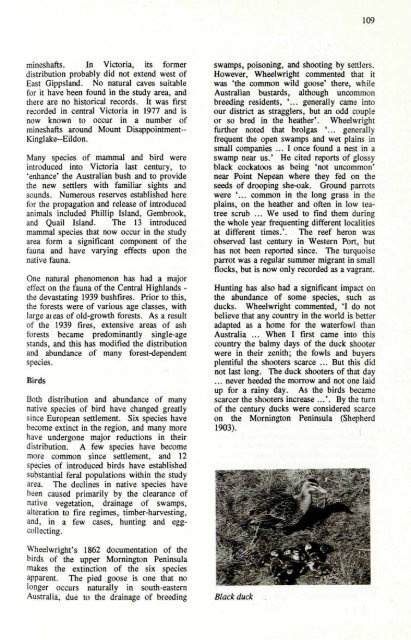Factors Affecting Flora Conservation - Victorian Environmental ...
Factors Affecting Flora Conservation - Victorian Environmental ...
Factors Affecting Flora Conservation - Victorian Environmental ...
Create successful ePaper yourself
Turn your PDF publications into a flip-book with our unique Google optimized e-Paper software.
109<br />
mineshafts. In Victoria, its former<br />
distribufion probably did not extend west of<br />
East Gippsland. No namral caves suitable<br />
for it have been found in the study area, and<br />
there are no historical records. It was first<br />
recorded in central Victoria in 1977 and is<br />
now known to occur in a number of<br />
mineshafts around Mount Disappointment-<br />
Kinglake—EUdon.<br />
Many species of mammal and bird were<br />
introduced into Victoria last century, to<br />
'enhance' the Australian bush and to provide<br />
the new settlers with famUiar sights and<br />
sounds. Numerous reserves established here<br />
for the propagation and release of introduced<br />
animals included Phillip Island, Gembrook,<br />
and Quail Island. The 13 introduced<br />
mammal species that now occur in the study<br />
area form a significant component of the<br />
fauna and have varying effects upon the<br />
nafive fauna.<br />
One natural phenomenon has had a major<br />
effect on the fauna of the Central Highlands -<br />
the devastating 1939 bushfires. Prior to this,<br />
the forests were of various age classes, with<br />
large aieas of old-growth forests. As a result<br />
of the 1939 fires, extensive areas of ash<br />
forests became predominanfly single-age<br />
stands, and this has modified the distribution<br />
and abundance of many forest-dependent<br />
species.<br />
Birds<br />
Both distribution and abundance of many<br />
native species of bird have changed greafly<br />
since European settlement. Six species have<br />
become extinct in the region, and many more<br />
have undergone major reductions in their<br />
distribufion. A few species have become<br />
more common since settlement, and 12<br />
species of introduced birds have established<br />
substantial feral populations within the study<br />
area. The declines in native species have<br />
been caused primarily by the clearance of<br />
native vegetation, drainage of swamps,<br />
alteration to fire regimes, timber-harvesting,<br />
and, in a few cases, hunting and eggcollecting.<br />
Wheelwright's 1862 documentation of the<br />
birds of the upper Momington Peninsula<br />
makes the extinction of the six species<br />
apparent. The pied goose is one that no<br />
longer occurs naturally in south-eastern<br />
Australia, due to the drainage of breeding<br />
swamps, poisoning, and shooting by settlers.<br />
However, Wheelwright commented that it<br />
was 'the common wild goose' there, while<br />
Australian bustards, although uncommon<br />
breeding residents, '... generally came into<br />
our disfrict as stragglers, but an odd couple<br />
or so bred in the heather'. WTieelwright<br />
further noted that brolgas '... generally<br />
frequent the open swamps and wet plains in<br />
small companies ... I once found a nest in a<br />
swamp near us.' He cited reports of glossy<br />
black cockatoos as being 'not uncommon'<br />
near Point Nepean where they fed on the<br />
seeds of drtwping she-oak. Ground parrots<br />
were '... common in the long grass in the<br />
plains, on the heather and often in low teatree<br />
scmb ... We used to find them during<br />
the whole year frequenting different localities<br />
at different times.'. The reef heron was<br />
observed last century in Western Port, but<br />
has not been reportexl since. The turquoise<br />
parrot was a regular summer migrant in small<br />
flocks, but is now only recorded as a vagrant.<br />
Hunting has also had a significant impact on<br />
the abundance of some species, such as<br />
ducks. Wheelwright commented, *I do not<br />
believe that any country in the world is better<br />
adapted as a home for the waterfowl than<br />
Australia ... When I first came into this<br />
country the balmy days of the duck shooter<br />
were in their zenith; the fowls and buyers<br />
plentiful the shooters scarce ... But this did<br />
not last long. The duck shooters of that day<br />
... never heeded the morrow and not one laid<br />
up for a rainy day. As the bfrds became<br />
scarcer the shooters increase ...'. By the turn<br />
of the century ducks were considered scarce<br />
on the Mornington Peninsula (Shepherd<br />
1903). J<br />
Black duck
















